Life and Major Accomplishments of Thomas-Alexandre Dumas, the first black general in the French army
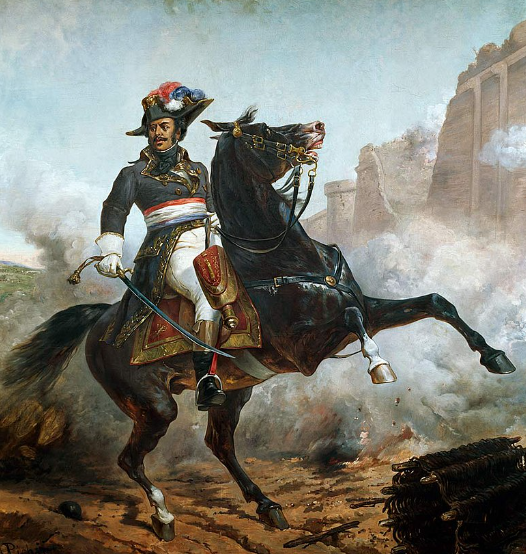
Alexandre Dumas was a brave and capable military general. He fought alongside Napoleon in many battles. Portrait du Général Dumas, painting by Olivier Pichat (1825–1912) in the Alexandre Dumas Museum
Read on to learn more about Dumas, as well as his tumultuous relationship with a “certain” Napoleon Bonaparte, and how he fathered a generation of successful descendants.
Childhood: Birth & Ethnicity
Dumas was born on March 25, 1762 in the town of Jeremie, Saint-Domingue (modern-day Haiti), which was at the time a French colony. As a matter of the colony was the richest possession of the French in the Caribbean.
His father was a white man named Marquis Alexandre Antoine Davy de la Pailleterie and his mother, Marie-Cessette Dumas, was a black slave. She was likely to have been shipped from Gabon or Dahomey in Africa.
Some accounts, however, claim that Dumas’s mother was called Louise, and that she was a free woman who managed a sugar plantation. As a result, some historians have stated that her name “Dumas” translates to “of the farm”.
Antoine had moved to Saint-Domingue some 24 years earlier to work on a sugarcane plantation with his brother, Charles. At that time, the island was a French colony, the richest French colony in the Caribbean for that matter.
Antoine worked on the plantation until 1748 when he was forced to leave the site after a bitter feud with his brother. During that period, he purchased Marie-Cessette, and she lived with him as his concubine. It was from this union that Dumas was born. It’s believed that at the time of Dumas’ birth, Antoine had been on the run from French authorities, as well as his brother.

Thomas-Alexandre Dumas was born to a white father and black mother in Saint Dominique, which at the time was the richest colony in the possession of France.
How and why Dumas’s father sold him into slavery
When Dumas was a teenager, his paternal grandfather died. But Antoine had no money to return to France. The trip back home was important to him because he had to claim his inheritance. To pay for his return to his home country, Antoine sold a 12-year-old Dumas into slavery for 800 livres to a French man named Captain Langlois.
It was a strategic sale, which included a right of redemption, to enable Dumas to easily travel to France and live there as a free man since France had abolished slavery. However, his mother and remaining siblings, Adolphe, Jeannette, and Marie-Rose, remained back home under the ownership of a French nobleman.
In late 1776, the young Dumas arrived in Le Havre, a port city in Normandy, where his father bought him from Langlois and set him free. He lived a relatively comfortable life with Antoine, who ensured that his son received education just like other young boys of French nobility. Dumas attended a boarding school in Paris, where he studied and excelled in weaponry, as well as literature and fencing.
Dumas’ mixed race, height and complexion caught the attention of 18th-century Parisians, who described him as an “exotic beauty.” His father’s investment into his education and appearance also gave him some prominence in French society.
Occasionally, his volatile character and loudmouthedness got him into trouble. Notwithstanding those excesses, Dumas quickly learned that although France did not allow slavery within its borders, the French society was not a perfect one. Often times, the young man felt that he did not belong due to his mixed race. One time in 1784, he was on the receiving end of a racial abuse and physical abuse from a white man.
Entry into the Military
Dumas’ strong relationship with Antoine came to a standstill when the latter took a second wife, Mari Retou. It’s likely that the two men fought over the union, but whatever the case was, Antoine took away his monetary support of his son.
In 1786, Dumas decided to enlist in the French military. But there was a slight issue. The French government had declared that only men of noble birth were allowed to serve in the army. While technically Dumas could do so, French race laws had made it increasingly difficult for people of mixed race to claim their nobility.
Therefore, he became a member of a cavalry unit known as the Queen’s Dragoons, which was a much lower position.
Antoine forced Dumas to give up his family name; so the young man adopted his mother’s maiden name and became known as Thomas-Alexandre Dumas. This action of his further shows how much he took enormous pride in his matrilineal lineage.
Although born to a father who was a nobleman, Dumas began as a private in the French military. Much like in Paris, it didn’t take long for the young man to become popular in the army. He also befriended three other men who would later become notable army generals: Jean-Louis Brigitte Espagne, Joseph Piston, and Louis-Chretien Carriere de Beaumont. It’s said that his friendships with these men inspired Dumas’ son, Alexandre Dumas, to write “The Three Musketeers.”
Dumas & the French Revolution

Best known as the first person of color in the French military to attain the rank of general, Alexander Dumas took enormous pride in his family heritage. He never saw his mixed race as a disadvantage.
In 1789, the France became unstable due to the French Revolution. During the outbreak of the revolution, Dumas had been deployed to the village of Laon for a year. He was then transferred to a village in northern France called Villers-Cotterets to help protect that region.
He returned to Paris in July 1791. The dragoons were under the command of Marquis de LaFayette who had been tasked by the French National Assembly to quell a citizens’ riot at Champ-de-Mars. The Parisians were enraged by the actions of the reigning king of France, Louis XIV, and called for his abdication. The clash between the Parisians and LaFayette’s men, including Dumas, turned bloody and it resulted in the deaths of at several dozens of people.
It was during the French Revolution that Dumas rose through the ranks. By 1792, he had reached the position of corporal and also had his first taste of fighting in battles. His first time was successful as he managed to capture 12 Austrian soldiers behind enemy lines in August 1792. That same year, he became the lieutenant-colonel of the Black Legion, a group of brave and efficient swordsmen who were all of mixed races (i.e. gens de couleur libres – free men of color). The group was also known as “American Legion” or Saint-George Legion. The latter name was derived from the group’s commander Chevalier de Saint-George.
Did you know: The Legion Noire (i.e. the Black Legion) was the first all-Black fighting unit in Europe?
Mr. Humanity (Monsieur de l’Humanité)
From then onward, his military career witnessed an upward trajectory; he received enormous praise for his fighting skills and strength, which allowed his unit to chalk up numerous military victories.
By the end of July 1793, he had been promoted to the rank of brigadier general in the army of the North.
By December 1793, he had been appointed commander-in-chief of the French army. He fought against Austria and captured over 1,000 prisoners. That victory helped France launch its Second Italian Campaign against Austria.
About a year later, he was appointed commander-in-chief of the army of the West in Vendée. He was tasked to put down a rebellion that had been instigated by a group of royalists. He successfully accomplished the mission by instilling discipline in his troops. Unlike other French generals of the time, he shunned away from inflicting pain and misery on communities that rebelled against the Revolution. He forbade his men from perpetuating abuses upon the locals. For this, he came to be called “Mr. Humanity”.
Unfortunately, those kind-hearted approach got him in hot waters as he was perceived by the higher-ups in Paris as a sympathizer of the counter-revolutionaries. Dumas was accused of treason and arrested. In all certainty, the young general was set to suffer similar fates as the countless politicians and generals that were guillotined during that period (i.e. the Reign of Terror).
Fortunately for Dumas, he never faced trial to defend the accusations levelled against him because the French revolutionary leader at that time, Maximilien Robespierre, was overthrown in a coup d’état and executed in late July 1794. With the death of Robespierre, Dumas was free and rejoined the military.
Did you know…?
- Dumas was a big supporter of republican ideals. This explains why he joined the all-black unit called “La Légion Américaine”.
- In just under two years, Dumas went from corporal to general of the division.
The Relationship Between Dumas and Napoleon Bonaparte
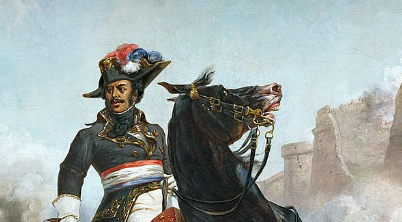
Thomas-Alexandre Dumas was a brave and capable military general. He fought alongside Napoleon in many battles.
In 1796, General Dumas joined the Army of Italy in Milan. This army was under the command of Napoleon Bonaparte, an astute and very capable French military general. Right from the start, it appeared that the two generals did not entirely get along and shared very different views. For example, Dumas did not agree with Bonaparte’s orders to needlessly destroy properties in the areas that they fought in.
Nonetheless, their strained relationship didn’t prevent Dumas from excelling in his position. He earned the nickname “The Horatius Cocles of the Tyrol” from Bonaparte after he successfully routed Austrian troops in Clausen (in South Tyrol in northern Italy) in March 1797. However, the opposing army nicknamed him “The Black Devil” (Diable Noir in French) due to the sheer terror he evoked in them.
A year later, in 1798, Dumas was sent on another military campaign, this time to conquer Egypt in North Africa. The plan was to limit Britain’s access to trade routes to its colonies in India, which would in turn have forced the British to pay heavy fines to France.
During the Egyptian campaign, he served as the commander of the French cavalry. It’s estimated that he had more than 3,000 men under his command.

It’s said that Napoleon Bonaparte, the famed French general and later emperor, had a strong appreciation of the military intelligence and bravery of Dumas. The Haitian-born general fought in Napoleon’s Italian campaign between 1796 and 1797. Image: Emperor of the French Napoleon Bonaparte
Dumas embarked on the mission together with Bonaparte. The French troops managed to conquer Malta, which they had planned to use to store supplies.
The French military then sailed to Alexandria, brought the city under its control and then set their sights on Cairo. In Cairo, Dumas distinguished himself brilliantly at the Battle of the Pyramids (also known as the Battle of Embabeh) on July 21, 1798. The battle, which was fought about 9 miles away from the Great Pyramid of Giza, witnessed the French army defeat the local Mamluk fighters and then force their chieftan Murad Bey to flee to Upper Egypt. Shortly after, Cairo fell into the hands of Napoleon’s forces.
While there, Dumas’ troops faced attacks from the locals. It’s believed that they attacked Dumas and his men because they saw him to be leader of the French army due to his height and physical appearance. This belief reportedly wounded Bonaparte’s ego since he was seen as less attractive than Dumas. As a result, the relationship between the two generals further soured.
It is also said that relationship between Dumas and Napoleon deteriorated because Dumas had a somewhat low opinion of his commander.
The rest of the Egyptian campaign, which was an absolute fiasco, exposed more of the tension between the two men. Dumas was still unhappy with Napoleon’s leadership skills. Dumas and some generals attributed the disastrous Egyptian campaign to the poor leadership of Napoleon.
On the other hand, Bonaparte threatened to have Dumas executed for attempting to start a rebellion.
With the ongoing conflict between the two men, Dumas was asked to return to France, but he ended up staying in Egypt for two more years after the French ship was destroyed by the British navy, under the command of Horatio Nelson.
Dumas’s famous and daring charge into the Al-Azhar Mosque
While in Egypt, Dumas ended a riot in Cairo by charging into the Al-Azhar Mosque while riding his horse. Napoleon Bonaparte promised the general that he would commission a painting of the event to celebrate him. However, when the portrait (i.e. the Girodet painting)was completed 11 years later, it showed a white man on horseback. A further testimony to just how the French society of the era negatively viewed Dumas’ mixed race.
Imprisonment in Naples
The relationship between the two men turned sour even further, and Dumas was desperate to leave for France.
When he finally set sail for France in February 1799, together with some wounded army officers and other generals, bad weather forced them to stop in Naples, where he was arrested. Dumas had wrongly thought that the Kingdom of Naples was under the control of the Parthenopean Republic, who had earlier toppled King Ferdinand IV. Instead, the kingdom was in the hands of the Holy Faith Army, led by Cardinal Fbarizio Ruffo, a staunch ally of King Ferdinand.
If France wanted Dumas, they would have to pay a ransom. Unfortunately for the general, Napoleon Bonaparte had returned to their home country and seized power through a coup, i.e. the Coup of 18–19 Brumaire. Given their frosty relationship, the new French leader was not prepared to bring Dumas home.
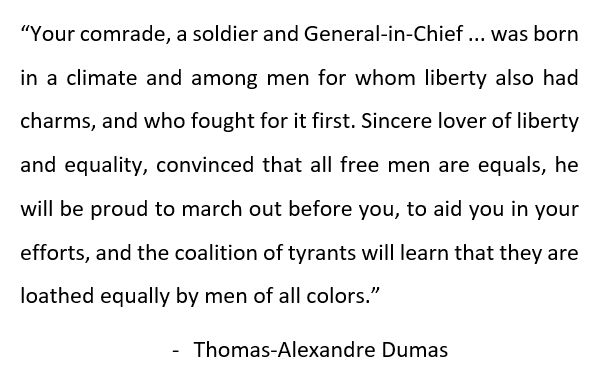
Dumas message to his forces in the Army of the Alps (February 4, 1794)
Release and later years of misery and abject poverty
Life in Naples as a prisoner was terrible for the general. Severely malnourished and isolated, Dumas was angry that no one had come for him. Therefore, he decided to seek revenge if he was ever freed.
However, when he eventually got out [kind courtesy to the months of lobbying by his wife] in 1801, he was in no shape or form to exact the type of revenge he wanted. He was nearly paralyzed and blind in one of his eyes. Dumas also accused his captors of slowly poisoning him.
When he returned to France, he requested that Bonaparte pay him for the Egyptian expedition, as well as compensate him for the awful years spent languishing in Naples. But Bonaparte rejected those requests and instead focused on looking for funds to support his conflict (i.e. the Napoleonic Wars) against the British and other European kingdoms.
As they were bitter rivals, Emperor Napoleon set about to make sure that Dumas’s name would be forgotten by the world.
The new French leader also brought back slavery in Saint-Domingue to help raise money for his wars. Additionally, he passed unfavorable race laws which limited the rights of mixed race people like Dumas. Because of these laws, Dumas never received his pension.
Dumas had lost all his property and spent the remainder of his life in abject poverty and plagued by illness, which he had suffered while being held prisoner in Naples.
In those very sad years, his only joy was perhaps the birth of his son, Alexandre Dumas, who later became distinguished writer.

Whereas Napoleon went on to become ruler and crown himself emperor of France, Dumas ended up imprisoned in a prison in Naples, forgotten and betrayed by the nation he had dedicated all his life to. On Sunday, December 2, 1804, Napoleon crowned himself Emperor of the French at spectacular ceremony in the Catholic cathedral of Notre-Dame de Paris
How did Dumas die?
Dumas died a poor man on February 26, 1806. He was 44 years. The cause of death was said to be stomach cancer. Interestingly, Bonaparte also died of stomach cancer in 1821.
It’s not known if he ever kept in contact with his mother and siblings back home. The general was survived by his wife Marie-Louise Labouret and three children.
Dumas’s wife: Marie-Louise Labouret
It’s said that Dumas met his wife, Marie-Louise, during his time at Villier-Cotterets (in today’s the Aisne department in Hauts-de-France) in August 1789. The small town had been gripped by the chaos that was sweeping throughout France following the French Revolution. Marie-Louise was the daughter of an inkeeper in the town. A few months later, the couple tied the knot. Together, the couple welcomed three children; a son, Alexandre, and daughters Louise-Alexandrine and Marie-Alexandrine.
His descendants
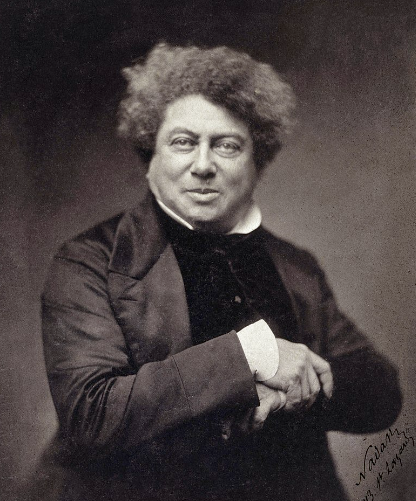
Alexandre Dumas (1802-1870) was the son of French general Thomas-Alexandre Dumas. Considered one of the greatest French writers, Alexandre Dumas penned numerous stories in the 1800s, famous among them “The Three Musketeers” and “The Count of Monte Cristo”. The latter was published in a French paper as sixteen part serial from 11844 to 1846.
At the time of Dumas’ death in 1806, his son, Alexandre Dumas, was only three. Though he grew up poor and without a basic secondary education, Alexandre Dumas went on to become a renowned storyteller, penning some of the world’s best novels like “The Three Musketeers”, “The Count of Monte Cristo”, and “The Man in the Iron Mask”, all inspired by his father’s military campaigns that his mother shared with him. His works are considered some of the most widely read books in the world, as they have been translated into many languages. They have also been adapted into many TV shows, movies and plays. There are some say that the French general is the real-life Count of Monte Cristo, the character from the novel.
Dumas’ grandson, Alexandre Dumas fils also became a successful playwright in France. His great-great grandson, Alexandre Lippmann (1881-1960), was a multiple-Olympic medalists, winning two gold, two silver, and one bronze. The French épée fencer competed at three Olympic Games: London (1908), Antwerp (1920), and Paris (1924). At the latter event, he won a team gold at the age of 42.
Posthumous Honors
In 1913, a statue of Thomas-Alexandre Dumas, which celebrates his African heritage, was erected at the Place du General Catroux in Paris. The statue, which was funded by the campaign of French journalist Anatole France and French actress Sarah Bernhardt, was destroyed by German forces in World War II. The Council of Paris agreed to rebuild an identical statue in 2021.
Two hundred years after his death, in 2006, two plaques were put up in his honor. The first plaque was placed in the home where he died, and the second can be found at the Col du Petit-Saint-Bernard, a mountain pass in the Alps on the France–Italy border.
Ever since May 10, 2009, which is the National Day of Remembrance of Slavery, a group called the Association of Friends of General Dumas gather to celebrate his memory, as well as that of other Haitian, French, and African slaves. That same year, a stele monument was erected in a park in the former commune of Evry.
In 2009, French writer Claude Ribbe launched an appeal to the French President Nicolas Sarkozy to award Dumas the Legion d’honneur. By 2014, his appeal had gained over 6,500 signatures.
General Dumas’ name can be found inscribed on the popular Arc de Triomphe, as well as the Place de l’Etoile.
American author and historian Tom Reiss’s 2012 biography of Thomas-Alexandre Dumas – “The Black Count: Glory, Revolution, Betrayal, and the Real Count of Monte Cristo” – bagged Reiss a Pulitzer Prize for Biography or Autobiography in 2013. Reiss’s work also won the PEN/Jacqueline Bograd Weld Award for Biography.
The French general appeared in the video game “Ambition: A Minuet in Power.”
In 2019, French author Christel Mouchard wrote about Dumas’ life as a slave in the book “Alex, son of slave.”

Dumas’s name is one of the many names inscribed on the Arc de Triomphe in Paris. The names are of the generals and soldiers that bravely fought in the French Revolutionary War and Napoleonic Wars. Image: The Arc de Triomphe de l’Étoile
Thomas-Alexander Dumas: Fast Facts
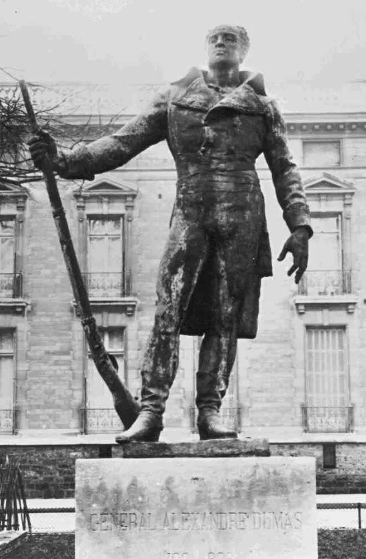
Aside from his military accomplishments, Thomas-Alexandre Dumas is famous for being the father of renowned French writer Alexandre Dumas. Inspired by the real life stories told by his father, the French author penned many famous works, including “The Count of Monte Cristo” and “The Three Musketeers”. Image: Statue of Thomas-Alexander Dumas that was later destroyed by the Germans in World War II
Born: March 25, 1762
Place of birth: Jérémie, Saint-Domingue (present-day Haiti)
Died: February 26, 1806
Place of death: Villers-Cotterêts, France
Cause of death: Stomach cancer
Notable wars fought in: French Revolutionary Wars (1792-1802), War in the Vendée (1793-1796), (Italian campaigns (1792-1802), Egyptian Campaign (1798-1801)
Notable battles fought in: Battle of the Pyramids (1798)
Parents: Alexandre Antoine Davy de la Pailleterie and Marie-Cessette Dumas
Spouse: Marie-Louise Labouret
Children: 3, including Alexandre Dumas
Why was Thomas-Alexandre Dumas called “The Black Devil”?
Dumas went by number of nicknames, some from his superiors, men and even opposing armies. For example, he was nicknamed “The Horatius Cocles of the Tyrol” by Bonaparte after he his heroics in Clausen (in South Tyrol in northern Italy) in March 1797. Horatius Cocles was a 6th century BC Roman officer who fought bravely against Rome’s enemies the Etruscans.
On the contrary, opposing army generals, who obviously were scared to death by Dumas tenacity and bravery in the field, nicknamed him “The Black Devil” (Diable Noir in French).
FACT CHECK: At worldhistoryedu.com, we strive for utmost accuracy and objectivity. But if you come across something that doesn’t look right, don’t hesitate to leave a comment below.
























